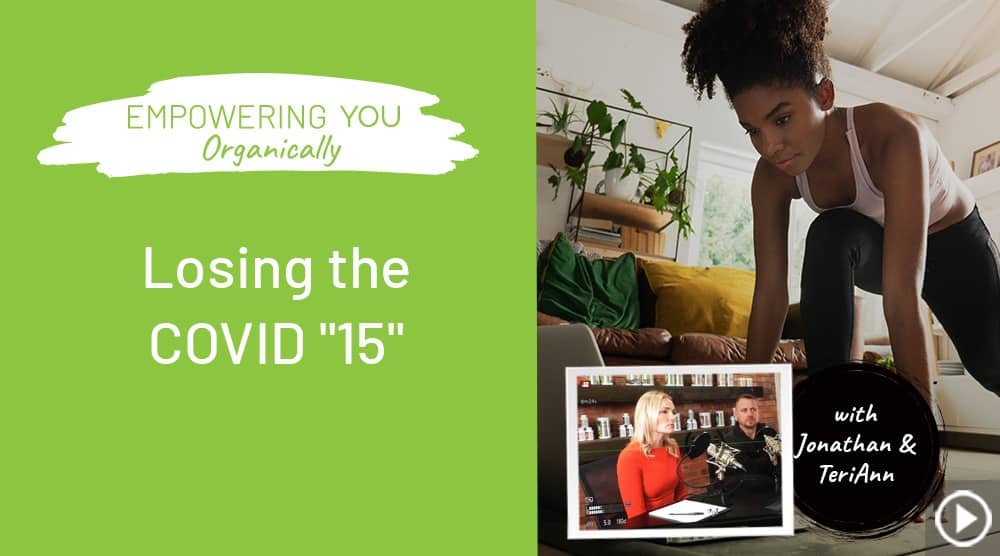Empowering You Organically – Season 12 – Episode 101
Title: Losing the COVID “15”
Hosts: Jonathan Hunsaker, TeriAnn Trevenen
Description: Have you found your healthy habits becoming a victim of the COVID-19 quarantine lifestyle? Jonathan. Tune in as he and TeriAnn discuss some great tips for losing that COVID-15 you may have put on! Learn the concept of a time-tested method to losing the weight today!
* * *
FEATURED PRODUCT
- USDA Certified Organic dehydrated green juice powder
- Made with 14 sprouted & fermented superfoods and botanicals for maximum nutrition
- 33 times more potent than juicing (with less work and mess!)
- Only 24 calories & 3g net carbs per serving
- Supports healthy immune function, detoxification, increased energy & mental clarity
- 17 different enzymes and a powerful natural probiotic to support overall gut health
- Non-GMO; No fillers, sweeteners, additives, artificial flavors, preservatives, colors, yeast, soy, added sodium, or starch
What’s the ‘calories in, calories out’ model?
The “calories in versus calories out” model is based on the idea that to maintain a stable weight, the number of calories you eat needs to match the number you expend.
“Calories in” refers to the calories you get from the foods you eat, while “calories out” is the number of calories you burn.
There are three main bodily processes that burn calories:
- Basic metabolism. Your body uses most of the calories you get from food to sustain basic functions, such as your heartbeat. This is commonly referred to as your basal metabolic rate (BMR) (1Trusted Source).
- Around 10–15% of the calories you eat is used to power digestion. This is known as the thermic effect of food (TEF) and varies based on the foods you eat (2Trusted Source, 3Trusted Source).
- Physical activity. The leftover calories you get from your diet are meant to fuel your physical activity, including workouts and everyday tasks like walking, reading, and washing dishes.
- When the number of calories you take in from food matches the number of calories you burn to sustain your metabolism, digestion, and physical activity, your weight will remain stable.
Thus, the “calories in versus calories out” model is strictly true. You need a calorie deficit to lose weight.
Because 3,500 calories equals about 1 pound (0.45 kilogram) of fat, it’s estimated that you need to burn about 3,500 calories to lose 1 pound. So, in general, if you cut about 500 to 1,000 calories a day from your typical diet, you’d lose about 1 to 2 pounds a week.
However, this depends on numerous factors. These include age, height, current weight, activity levels, metabolic health, and several others.
Plateauing
We have all been there. How do we avoid this?
- Every 3 weeks or so increase the calories back to starting point for a week and then drop them back down.
- This keeps the metabolism burning.
What the Studies Show
Some studies only report the total amount of weight lost, without mentioning whether the weight loss came from muscle, fat, or water losses.
Different diets affect muscle and water losses differently, which can make it seem as if they are more effective for fat loss when this isn’t truly the case.
Studies controlling for these factors consistently show that weight loss always results from a calorie deficit. This is true regardless of whether your calories come from carbs, fat, or protein.
The source of calories has different effects on your metabolism
Foods affect your metabolism differently. For instance, some require more work to digest, absorb, or metabolize than others. The measure used to quantify this work is called the thermic effect of food (TEF).
The higher the TEF, the more energy a food requires to be metabolized. Protein has the highest TEF, while fat has the lowest. This means that a high-protein diet requires more calories to be metabolized than a lower-protein diet does.
This is why eating protein is often said to boost your metabolism to a greater extent than eating carbs or fat. That said, when it comes to weight loss, the TEF of foods appears to have only a small effect on your calorie balance.
A Caution…Why nutrient density matters
The amount of nutrients a food contains per calorie can vary greatly.
Nutrient-dense foods provide higher amounts of vitamins, minerals, and beneficial compounds per gram compared with less nutrient-dense foods.
For instance, fruits are much more nutrient-dense than donuts. Calorie for calorie, fruit will provide a much larger dose of vitamins, minerals, and beneficial plant compounds.
Other examples of nutrient-dense foods include vegetables, whole grains, legumes, meat, fish, poultry, dairy products, and unsalted nuts and seeds.
On the other hand, processed foods, including white pasta, soda, cookies, chips, ice cream, and alcohol are considered to have a low nutrient density.
Diets rich in nutrient-dense foods are consistently linked to a lower risk of chronic diseases, such as diabetes and heart disease, and may even help you live longer.
* * *
Subscribe to Empowering You Organically
Never miss an episode!
APPLE PODCASTS SPOTIFY GOOGLE PODCASTS





